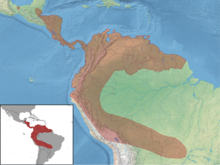Large spit leaf nose
| Large spit leaf nose | ||||||||||||
|---|---|---|---|---|---|---|---|---|---|---|---|---|

Specimen from the National Museum of Natural History in Washington, DC . |
||||||||||||
| Systematics | ||||||||||||
|
||||||||||||
| Scientific name of the genus | ||||||||||||
| Vampyrum | ||||||||||||
| Rafinesque , 1815 | ||||||||||||
| Scientific name of the species | ||||||||||||
| Vampyrum spectrum | ||||||||||||
| ( Linnaeus , 1758) |
The large spit-leaf nose ( Vampyrum spectrum ) is a bat species from the subfamily of the lance noses (Phyllostominae). It is the largest bat on the American continent .
description
The large spit blade nose reaches a head body length of 12.5 to 13.5 centimeters, a wingspan of 76 to 102 centimeters and a weight of 145 to 190 grams. Their fur is red-brown in color, the underside is a little lighter. Characteristic are the missing tail, the elongated snout with the large nasal sheet and the large round ears.
Way of life
Like most bats, these animals are nocturnal; during the day they sleep in small groups of up to five animals in tree hollows. These groups usually consist of a male, a female and their offspring. These monogamous relationships are long-lasting, and the partners may stay together for their entire life. When the kittens are small, one parent stays with them while the other goes foraging. When they return, the prey is shared with the partner who stayed behind and the offspring.
As the generic name, Vampyrum , suggests, the large spit leaf noses were mistaken for blood-eating vampire bats in the past . But they are carnivores that feed on birds, smaller bats and rodents.
Reproduction
Little is known about the reproduction of these animals. As with most bats, a single hatchling is usually born, presumably at the end of the dry season. Both parents take care of the offspring.
distribution and habitat
These bats live in central and northern South America , their range extends from southern Mexico to Peru and central Brazil . Their habitat is primarily primary rainforests up to 1600 meters above sea level, and they are often found near bodies of water or in swamps. Although the great spit leaf nose has a large distribution area, it is affected by the clearing of the forests. It is also rarely caught or watched and is likely to be sensitive to habitat fragmentation and other human influences. The IUCN lists the species as endangered and indicates a decline in populations.
literature
- Ronald M. Nowak: Walker's Mammals of the World . Johns Hopkins University Press, 1999 ISBN 0-8018-5789-9
swell
Web links
- Vampyrum spectrum in the endangered Red List species the IUCN 2006. Posted by: Chiroptera Specialist Group, 1996. Retrieved on 11 May, 2006.
